Before you write the address, fold the envelope, or hit send on the email…
Stop.
That important legal document? It could end up gathering dust in a mail facility for weeks—all because you missed the ZIP+4 code.
That dream job? You might never hear back, just because you wrote “Dear Sir/Madam” instead of spending a minute to look up the hiring manager’s name.
That heartfelt thank-you note to your mentor? They’ll never see it if you botched their title.
Most people think addressing a letter is just giving AI some prompts, adding a name and address to it and folding the envelope.
Wrong.
It’s your first impression, your silent handshake, your chance to show you actually care enough to get the basics right.
In this blog, we cover everything from the basics of writing a letter and how to address it, to unique scenarios like addressing a letter to a judge, a couple, or even without a name.
We also explore the international addressing system and the AI tools that can help along the way.
Let’s dive in.
What You Need Before Addressing a Letter
Before you write a letter, make sure you have the correct details. Missing just one small thing can delay delivery or make the letter look unprofessional.
Here’s what you need to know about how to address a letter properly:
1. Recipient’s Full Legal Name
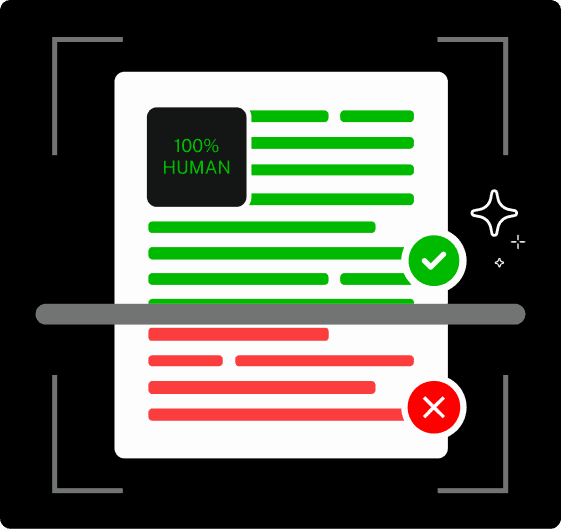
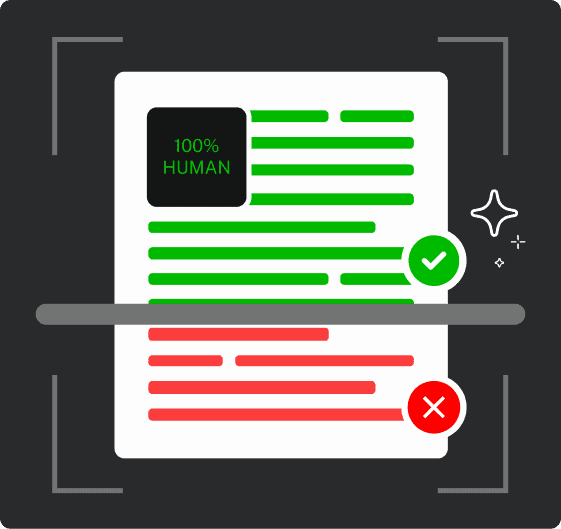
Never Worry About AI Detecting Your Texts Again. Undetectable AI Can Help You:
- Make your AI assisted writing appear human-like.
- Bypass all major AI detection tools with just one click.
- Use AI safely and confidently in school and work.
Always use the person’s full legal name—first, middle (if known), and last. This is crucial, especially if you’re figuring out how to address a cover letter or a formal business letter.
For Example:
✔ Jonathan Lee
✘ Jonny L.
2. Complete Mailing Address with ZIP+4 Code
Always double-check the address. If you’re unsure how to write an address on a letter, start with:
- Street number and name
- City, state, ZIP+4 code
This is especially important when sending formal mail or if you’re unsure how to address a cover letter without a name and need to rely on department info instead.
3. Proper Titles and Honorifics
Titles show respect. Use Mr., Ms., Dr., or a job title like “Director of Marketing.” In 2025, gender-neutral options like Mx. are more common—especially if you’re unsure of the recipient’s gender identity.
Examples:
- Mr. David Kim
- Dr. Aisha Patel
- Mx. Jordan Rivers (gender-neutral)
4. Company Information (If Applicable)
If writing to someone at a company, include their department, division, or building number. Large organizations often have many locations and mailrooms.
Example:
Jane Smith
Hiring Manager, Marketing Department
XYZ Corporation
200 West Main St, Building B
You can use these resources to find accurate details:
- USPS Address Verification Tool – Confirms U.S. addresses and ZIP+4 codes.
- International postal code search – “Postal Codes Michigan, United States.”
- LinkedIn – Look up job titles, departments, or companies.
- Company websites – Often list mailing addresses under “Contact Us.”
How to Address a Letter: Format Breakdown
1. Return Address Placement
The return address part goes on the envelope and sometimes at the top of the letter itself.
Standard Format (U.S. & Most Countries)
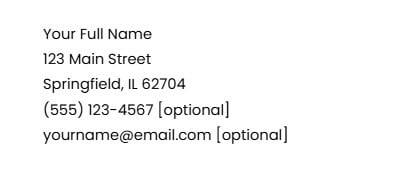
You can skip the phone number and email if it’s a personal note—but they help in business letters.
The placement of your return address depends on the type of letter:
| Type | Placement |
| Business/Formal | Top-left corner, 1 inch from top/left |
| Personal (letterhead) | Centered at the top |
| Envelope (personal) | Back flip of envelope (optional) |
Example of Personal Letters
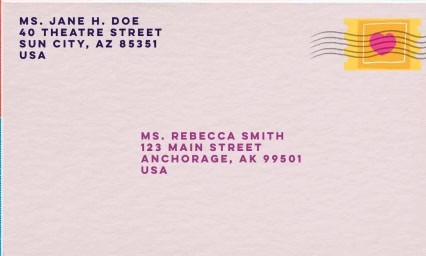
Source = Today.com
Example of Branded Letterhead
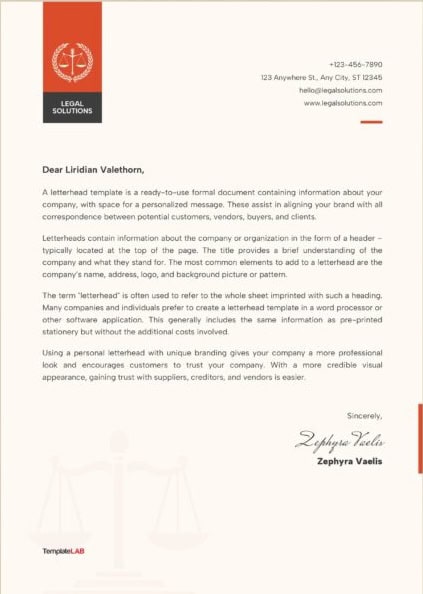
Source = Template Lab
2. Date Line
Here are the different ways you can format and place the date:
The Standard Format is:
Example: January 15, 2025
- Format: Full month name + day + year (with a comma)
- Usage: Preferred in U.S.-based corporate and professional correspondence.
The International Alternatives are:
Examples:
- 15/01/2025 (used in the UK, EU, and Commonwealth countries)
- 2025-01-15 (ISO 8601 format – common in data-centric or international documents)
Here is the placement guideline of date:
| Format Type | Placement | Alignment |
| Block Format | 2–3 lines below the return address | Left-aligned |
| Semi-Block or Modified Block Format | 2–3 lines below the return address | Right-aligned |
For example,
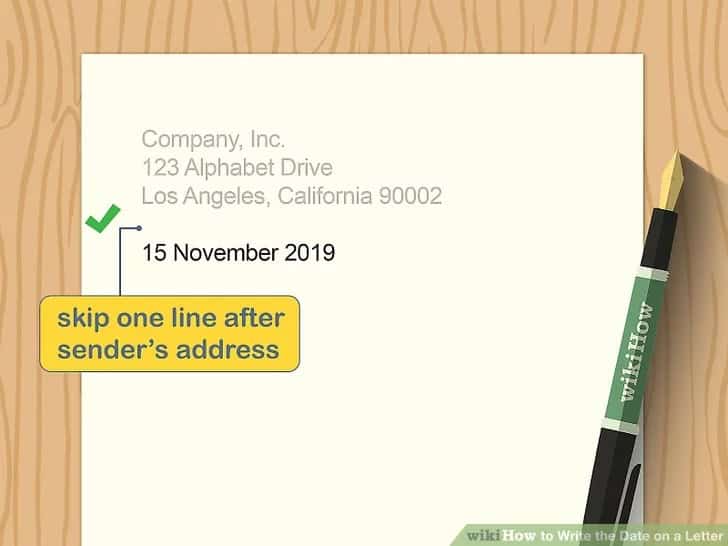
Source = Wikihow
3. Inside Address
The Inside Address appears two lines below the date line, aligned left, and follows this complete format:
Complete Format (Top to Bottom)
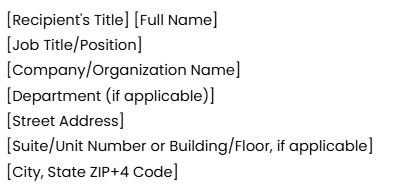
Title Guidelines
| Title | Examples | Notes |
| Traditional | Mr., Ms., Mrs., Dr., Prof. | Still widely used. Default to “Ms.” if unsure of marital status. |
| Gender-Neutral | Mx., [No Title] | Use “Mx.” when gender is unknown or nonbinary; omitting title is also acceptable. |
| Professional | CEO, Director, Attorney, Officer, Engineer | Include after the name when relevant (e.g., “Jane Doe, CEO”). |
| Academic | PhD, MD, JD, DDS | Placed after the name, e.g., “John Smith, PhD” (not with “Dr.” in that case). |
Company Addressing Best Practices
- For Large Organizations: Use Attention line (e.g., “Attn: John Smith”) to route accurately.
- For Department-Specific Communication: Include Department Name beneath company name.
- For Multi-building corporate campuses: Add Building, Floor, Suite, or Unit Number as needed.
- For International Mailing: Include country name in CAPS and follow local postal formatting.
Example Inside Address

Properly formatting the inside address improves delivery, professionalism, and first impressions—especially in formal or high-stakes correspondence.
4. Salutation Examples
The salutation appears two lines below the inside address, aligned left, and ends with a colon (:) in formal writing.
Standard & Modern Salutations (2025)
| Salutation | Best Use |
| Dear Mr./Ms. [Last Name] | Traditional, formal—use when gender and surname are known. |
| Dear Dr. [Last Name] | For people with medical or academic titles. |
| Dear [Full Name] | When the gender is unknown or a neutral, respectful option is needed. |
| Dear [First Name] [Last Name] | Now widely accepted in professional contexts (modernized form). |
| Hello [Name] | Semi-formal—use with established contacts or less formal industries. |
| Greetings | Gender-neutral and formal—use when unsure of titles or names. |
Special Scenarios: Addressing Unique Recipients
Professional correspondence doesn’t always follow a one-size-fits-all format. Here’s how to tailor your approach:
Addressing a Letter to a Company
Use this when writing to a business entity rather than an individual. Precision here ensures your message lands on the right desk—fast.
Format Example:
ATTN: Accounts Payable Department
XYZ Corporation
123 Enterprise Ave., Suite 456
San Diego, CA 92101
Here are the best practices:
- Always include “ATTN” for proper routing—especially in larger organizations.
- Use department names rather than vague titles (e.g., “Accounting Department” vs. “To Whom It May Concern”).
- Include a reference number (e.g., invoice ID) for faster internal processing.
Example of a Formal Letter
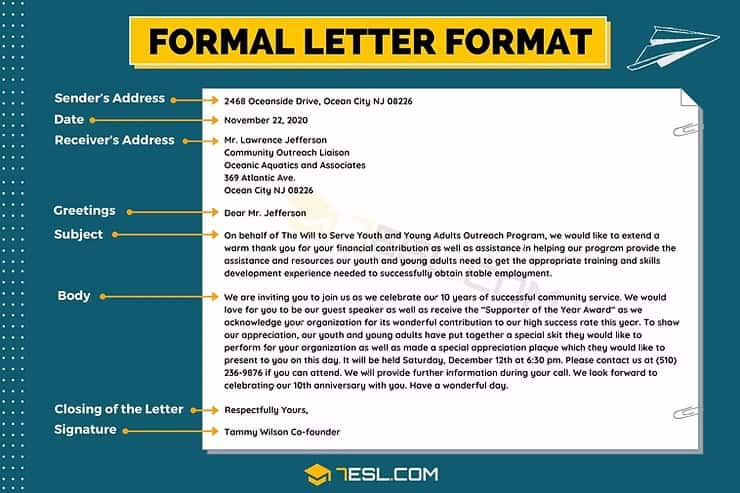
Source = Peak Frameworks
Addressing a Letter to a Couple or Family
Context is key here—how well do you know them, and what’s the occasion?
| Scenario | Recommended Format |
| Traditional married couple | Mr. and Mrs. John Smith |
| One holds a professional title | Dr. and Mrs. Smith |
| Modern couple, same last name | John and Jane Smith |
| Same-sex couple | Mr. John Smith and Mr. David Johnson |
| Different last names | Ms. Jane Doe and Mr. John Smith |
| Including children | The Smith Family OR Mr. and Mrs. Smith and Family |
Addressing a Letter Without a Name
If you don’t know the recipient’s name, consider one of these options:
- Dear Hiring Manager: Use for job applications or HR-related communication.
- Dear [Department] Team: Ideal when addressing a specific group (e.g., “Dear Finance Team”).
- To Whom It May Concern: Outdated and impersonal—use only as a last resort when no identifying information is available.
Here are the quick best practices:
- Always research the recipient’s name when possible—LinkedIn and company websites are your allies.
- Do not assume anyone’s gender. When in doubt, use full names or gender-neutral options like “Greetings.”
- Startups, nonprofits, or tech companies may expect more relaxed salutations than traditional firms or government agencies.
Example Applications
- Dear Ms. Thompson
- Hello Alex
- Dear Customer Success Team
- Greetings
If any greeting sounds too casual, you can go to the AI Chatbot. For example, if you’re unsure of someone’s gender, ask AI to rewrite your greeting with neutral language.
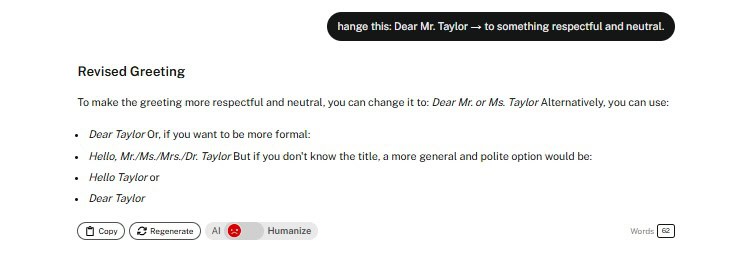
Or you can try other prompts such as:
- Give me 5 greeting options for a nonprofit role at an animal rescue organization. I don’t know the recipient’s name.
- Make this greeting sound more casual but still respectful: Dear Customer Success Team.
- I’m writing a cover letter to a marketing role at Canva, but I don’t know the name. Can you suggest a good greeting?
International Addressing Tips
Before diving into the country-specific addressing tips, here are the universal principles that you need to follow in every international letter.
- Always write the destination country’s name in English, in capital letters. (e.g., USA, CANADA, INDIA).
- Follow the local address format and language to avoid delays.
- Verify postage requirements locally (in-person or online), as rates vary by destination.
- Remote areas might have longer delivery times. You can plan your follow-ups accordingly.
Sample: UK, Canada, India
1 – United Kingdom
If you’re mailing to the UK, your address should look like this:
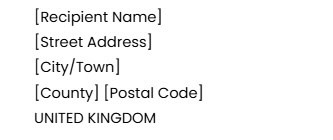
The Royal Mail relies on the postcode, which is a specific code made of letters and numbers.
It must be correct and in the right place. If it’s wrong or misplaced, your mail might get stuck in sorting.
Also, keep the address to 7 lines or fewer to fit standard envelopes. Too much information can cause problems, not help.
2 – Canada
Canadian addresses are straightforward but come with a bilingual twist:
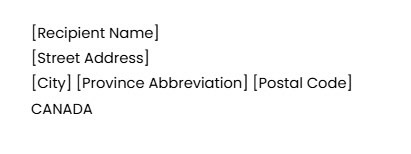
The postal code follows a very specific format (like M5V 3L9), critical for speedy sorting.
Plus, remember that Canada officially uses both English and French. Match the language preference of the region you’re sending to; this shows respect and attention to detail.
Also, always use the official two-letter provincial abbreviations (e.g., QC for Quebec).
3 – India
India’s addressing system uses a six-digit PIN code to sort mail efficiently
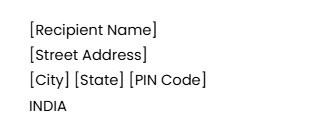
This PIN code is essential. Don’t skip it or get it wrong—it’s the equivalent of a zip code on steroids. A
Also, specify the correct state or union territory.
Unlike some countries, India has a diverse mix of languages and addressing customs, so adding the English version of the address ensures your mail moves smoothly through international channels.
Curious about our AI Detector and Humanizer? Try them in the widget below!
FAQs
How do I address a cover letter?
Use the hiring manager’s name if possible: “Dear Ms. Patel:” or “Dear Dr. Kim:”. If unknown, use “Dear Hiring Manager:”.
Use Cover Letter Generator to format everything professionally. For faster applications, try the Smart Applier and pair it with our Resume Builder for a complete, polished package.
How do I write an address on a letter?
Start with the recipient’s name and title, followed by their position, company, and full mailing address.
How do I address a judge in a letter?
Use “The Honorable [Full Name]” in the address line, and “Respectable Judge [Last Name]:” in the salutation. Always use formal language and never use the judge’s first name.
Conclusion
Does the way you format a letter really matter?
Absolutely.
A well-addressed letter creates first impressions. Whether you’re applying for a job, addressing a judge in a letter, or reaching out to a company, small details like titles, spacing, and spelling signal professionalism and respect.
A minor slip—like misplacing a postcode or using the wrong salutation—can undermine your credibility.
That’s why smart tools like our Cover Letter Generator, Smart Applier, and Resume Builder exist: to automate the details, reduce human error, and help you present yourself with confidence.
Before sealing the envelope (or hitting send), ask yourself:
– Is this the correct format for the recipient’s country or profession?
– Have I verified the spelling of names and titles?
– Would this letter make me look sharp or sloppy?
Final tip: Respect cultural etiquette, double-check everything, and let the tools handle the formatting—so you can focus on what matters most: the message.
